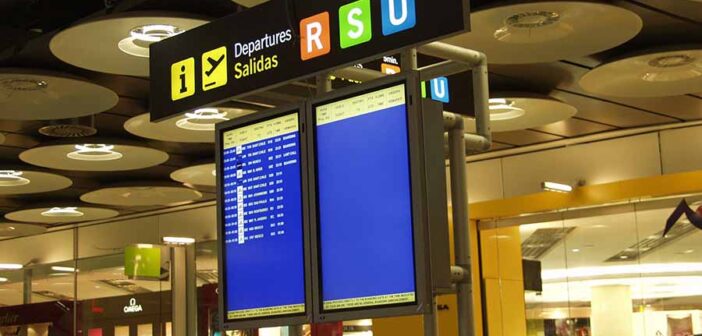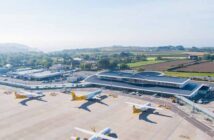Adolfo Suلrez Madrid–Barajas Airport, located 13 kilometres northeast of Madrid’s city centre in the Barajas district, serves as Spain’s busiest airport, handling over 61 million passengers annually. As a major hub for Iberia and Air Europa, it connects to over 200 destinations across five continents with airlines like Ryanair, easyJet, and Emirates. Its excellent transport links and modern facilities make it a practical gateway for travellers exploring Spain or connecting globally.
Accessing the airport is convenient, with multiple transport options linking it to Madrid and beyond. The Metro Line 8 connects Terminals 1, 2, 3, and Terminal 4 to Nuevos Ministerios in the city’s financial district in about 20 minutes, with tickets costing €5 including the airport supplement. The Airport Express Bus (Line 203) runs 24 hours to Atocha station via Cibeles, taking 40 minutes for €5. Renfe’s C1 train serves Terminal 4, reaching Atocha or Chamartيn in 25 minutes for €3, free for same-day AVE ticket holders.
Taxis offer a flat rate of €30 to the city centre, while rideshare services like Uber or Bolt cost €24 to €30, depending on traffic. Drivers can access the airport via the M-11 or A-2 motorways, with 10,000 parking spaces across short-term, long-term, and express lots, starting at €5 for two hours. A free drop-off zone is available outside terminals, with shuttles connecting distant car parks.
The airport comprises four terminals—T1, T2, T3, and T4, plus the satellite T4S—designed for efficiency. Terminals 1, 2, and 3, located in one complex, serve SkyTeam, Star Alliance, and low-cost carriers like Ryanair, with T1 handling international flights, T2 focusing on Schengen routes, and T3 acting as an extension of T2. Terminal 4 and T4S, connected by a 3-minute automated people mover, are home to Iberia and Oneworld airlines, handling both Schengen and non-Schengen flights. Clear signage in English and Spanish guides passengers, with walking times between T1, T2, and T3 around 10 minutes, while a free shuttle bus links T1–T3 to T4 every 5 to 20 minutes.
Security typically takes 10 to 20 minutes, but peak hours (6–9 am) or staffing shortages can extend queues to 45 minutes, as noted on X. Fast Track security, from €10, helps bypass delays. Travellers should arrive two hours early for domestic flights and three hours for international ones.
Dining and retail options are extensive, particularly in T4 and T4S, which cover 138,000 square metres of shopping space. Airside, passengers can enjoy Spanish cuisine at Sibarium Delicatessen, pastries at Mama Framboise in T1, or international fare at Starbucks and KFC across terminals. Family-friendly menus and grab-and-go options are plentiful, though prices are higher than in Madrid’s city centre. Retail includes duty-free shops from Aelia in all terminals, offering cosmetics, alcohol, and local delicacies like jamَn, alongside luxury brands like Loewe and Zara. Relay and Fnac provide travel essentials and electronics. Budget travellers may prefer city shops to save costs.
Facilities are comprehensive, with free unlimited Wi-Fi via the “Airport Free Wifi Aena” network, requiring email registration, and charging stations throughout. Family amenities include children’s play areas in T2, T4, and T4S, baby-changing rooms, and free pram rentals post-security. Accessibility is prioritised, with ramps, lifts, and assistance for passengers with reduced mobility, bookable 24 hours in advance. Lounges like the Cibeles Lounge in T1 or Iberia’s Dalي Lounge in T4 offer snacks, drinks, and showers for €35 to €41, with Priority Pass access available. Medical services, 75 cardiac rescue points, a pet zone outside T1, and chapels in T1 and T4 cater to diverse needs. However, seating at gates, particularly in T1, can be limited, with some passengers reporting insufficient chairs during peak times.
On-time performance faces challenges, with recent data indicating a 30-minute average delay for departures, often due to air traffic control shortages, weather like fog, or baggage handling issues, as reported on Flightradar24. T4’s automated baggage system handles 16,500 pieces hourly, but delays can occur during high traffic. Passengers are advised to check flight statuses via the airport’s website, Aena app, or Flightradar24.
Connections are efficient, with minimum connection times of 20 minutes for domestic-to-domestic, 60 minutes for domestic-to-international, and 60 minutes for international-to-international transfers. Walkways connect T1, T2, and T3, while the people mover links T4 to T4S. Passengers transferring between T1–T3 and T4 must use the shuttle bus and may need to re-clear security, requiring 2 to 3 hours for separate tickets. Immigration for non-Schengen arrivals can take up to 45 minutes during peak periods, so travellers on budget airlines should plan longer layovers.
Potential delays are often linked to weather, air traffic control constraints, or operational issues like slow baggage delivery, with some X users reporting 1.5-hour waits at baggage claim. Congestion at security or passport control, particularly in T1 and T4S, can also slow the process. Travellers should check terminal assignments and allow extra time during morning rushes.




